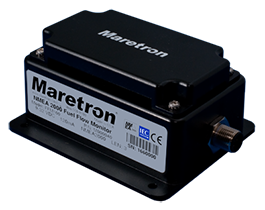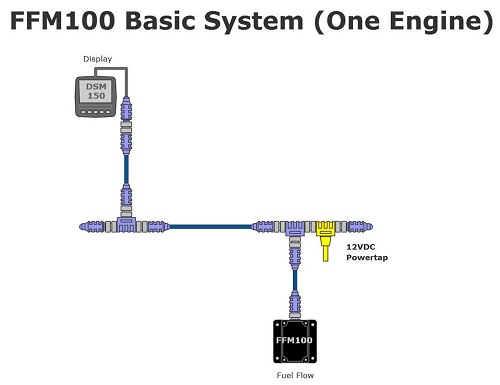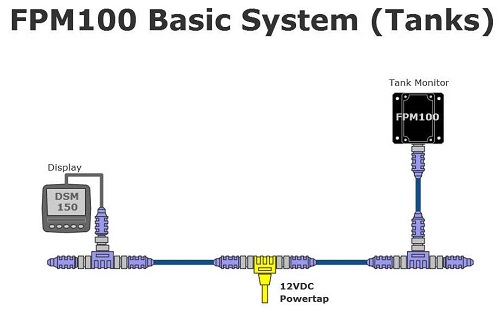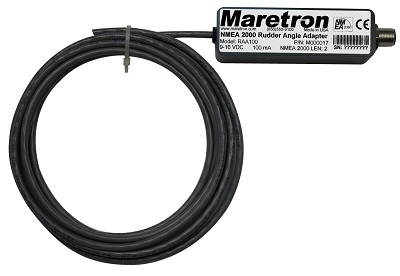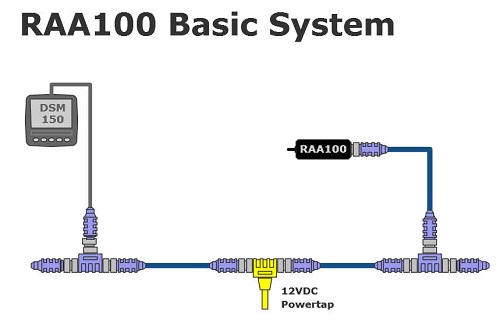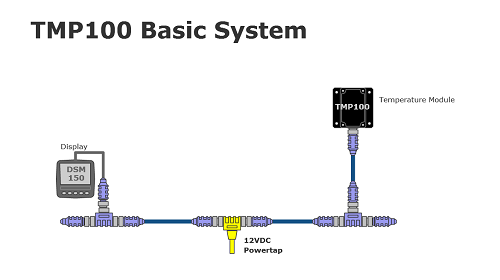General systems monitoring/recording
CLM100

Maretron’s CLM100 converts commercially available 4-20mA current loop transducers into digital data so a wide variety of information can be displayed on compatible NMEA 2000® displays. Numerous 4-20mA current loop transducers are supported by the CLM100 including transducers for monitoring DC voltage and current, flow rate, distance, linear velocity and acceleration, angle, angular velocity and acceleration, temperature, humidity, resistance, strain gauges, force (load cells), pressure, decibels, and rotational rate. Some typical applications where the CLM100 is used together with a commercial available 4-20mA transducers include machinery monitoring using accelerometers and vibration sensors. Vibration monitoring of pumps, motors, fans, compressors, and gear boxes provides an early warning of potential problems resulting fewer breakdowns and reduced maintenance expenses.
Another application example using the CLM100 is shaft speed monitoring. A commercially available 4-20mA rotational rate sensor is coupled to the shaft of interest and the CLM100 converts the transducer data to an RPM that can be read by a compatible NMEA 2000® display. And if you’re concerned about the force exerted on a mast stay or perhaps a vessel tow attachment point, commercially available clevis pins with a 4-20mA interface can be connected to the CLM100 and the corresponding load monitored using any of Maretron’s display products.
The CLM100 is NMEA 2000® certified so you can view any and all information anywhere on the vessel using a compatible NMEA 2000® display. The CLM100 is a key component of Maretron's N2KView® vessel monitoring and control system.
Features:
- Six Channels
- Each channel independently programmed
- Used Together with Commercially Available 4-20mA Current Loop Transducers
- Converts Analog Transducer Data to Digital Data (NMEA 2000®)
- Digital Data Displayed on All Maretron Displays
Applications:
- Voltage Measurement
- Current Measurement
- Distance Measurement
- Linear Velocity Measurement
- Linear Acceleration Measurement
- Angle Measurement
- Angular Velocity Measurement
- Angular Acceleration Measurement
- Flow Rate Measurement
- Temperature Measurement
- Humidity Measurement
- Resistance Measurement
- Strain Gauge Measurement
- Force Measurement
- Pressure Measurement
- Decibel Measurement
- Rotational Rate Measurement
Download documents: CLM100 Datasheet CLM100 User Manual
FFM100
Maretron's FFM100 provides precision fuel flow information to help optimize fuel consumption, which can save thousands of dollars in fuel operating cost. The FFM100 uses state-of-the-art, positive displacement metering technology for unprecedented accuracy. In fact, the accuracy of the FFM100 is nearly that of commercial vessel systems costing tens of thousands of dollars, yet the FFM100 cost less than existing recreational systems found on the market today. Additional benefits of the positive displacement metering technology are the elimination of flow conditioning components such as straighteners and pulsation dampers. Other flow meter technologies require flow conditioning components that increase system and installation cost. The FFM100 also uses true temperature compensation with embedded temperature sensors within the meters. The returning fuel is generally hotter than the supply fuel and if not properly compensated, inaccuracies as much as 5% can occur in computing the engine's fuel consumption. The FFM100 also detects momentary reverse flow in the fuel lines due to fluctuating pressure caused by the injection pump. Less accurate systems count the reverse fuel flow as part of the consumed fuel where the FFM100 properly accounts for momentary reverse flow.
Lastly, the FFM100 can be used for fluid types other than fuel (e.g., water, oil, etc.) by ordering the appropriate flow sender.
The FFM100 is NMEA 2000® certified so you can view any and all information anywhere on the vessel using a compatible NMEA 2000® display. The FFM100 is a key component of Maretron's N2KView® vessel monitoring and control system.
Features:
- FFM100 converts a variety of flow senders (e.g., fuel, water, etc.) to NMEA 2000® Network Data
- All flow senders ordered separately depending on application (i.e., single fuel flow sender for gas engine, dual fuel flow senders for diesel engine, water flow sender for sea water, etc.)
- Fuel flow senders facilitates fuel consumption optimization for reduced fuel operating cost
- Fuel flow senders use positive displacement metering technology for superior accuracy over other measurement technology such as turbine meters
- Fuel flow senders do not require costly fuel conditioning components like flow straighteners and pulse dampers
- Fuel flow senders implement true temperature compensation with precision built-in thermistors for increased accuracy
- Fuel flow senders automatically detect reverse flow due to fluctuating pressure difference from injection pumps
- Fuel flow senders pass particle sizes up to 70 micrometers (diesel fuel filters normally filter down to 2 micrometers to prevent clogging injectors)
Applications:
- Diesel Fuel Flow Monitoring
- Gasoline/Petrol Fuel Flow Monitoring
- Cooling Water Flow Monitoring
Download documents: FFM100 Datasheet FFM100 User Manual FFM100 Flyer
FPM100
Maretron's Fluid Pressure Monitor is used to adapt up to six pressure transducers to the NMEA 2000® network (pressure transducers sold separately). This allows you to observe fluid pressures and tank levels anywhere on the vessel where there are NMEA 2000® compatible displays. With the appropriate transducer, the FPM100 reports either pressure or vacuum for a variety of applications including water pressures, oil pressures, hydraulic pressures, or system vacuum for detecting clogged filters.
The FPM100 also has a tank level mode, so that fluid levels in a tank can be monitored via a pressure transducer mounted at the bottom of the tank and transmitted over the NMEA 2000® network. This allows you to monitor the fluid levels in tanks that are extremely deep, have internal structures, or are otherwise not suited for other tank level sensing technologies. In this mode, the FPM100 can be calibrated for irregular tank shapes so that you know the true level of the tanks.
The FPM100 is NMEA 2000® certified so you can view any and all information anywhere on the vessel using a compatible NMEA 2000® display. The FPM100 is a key component of Maretron's N2KView® vessel monitoring and control system.
Features:
- Adapts up to six pressure transducers to the NMEA 2000® network
- Each channel independently programmed to match pressure transducer characteristics
- Each channel independently programmed in pressure/vacuum mode or tank level mode
- In Tank Level Mode, measures levels of extremely deep or irregularly shaped tanks
Applications:
- Water Pressure
- Atmospheric Pressure
- Compressed Air Pressure
- Hydraulic Pressure
- Steam Pressure
- User Defined Pressure Sources
- Fuel Tank Level / Volume Remaining
- Fresh Water Tank Level / Volume Remaining
- Waste Water Tank Level / Volume Remaining
Download documents: FPM100 Datasheet FPM100 User Manual
RAA100
The RAA100 is used to adapt commercially available resistive rudder angle senders to the NMEA 2000® network. This allows you to observe rudder angle anywhere on the vessel where there is an NMEA 2000® compatible display such as Maretron's N2KView® vessel monitoring system, or Maretron's DSM250 / DSM410 color graphics displays.
The RAA100 is compatible with both the American standard (240-33 ohm) and the European standard (10-180 ohm) resistive senders. In fact, the RAA100 can be calibrated for any resistance between 0 and 300 ohms.
You can also use the RAA100 with existing analog gauges so you don't have to give up your existing analog gauges to enjoy the advantages of digitally networked information.
Features:
- Rudder angle
- Rudder order
Application: Rudder angle senders
Download documents: RAA100 Datasheet RAA100 User Manual
SIM100
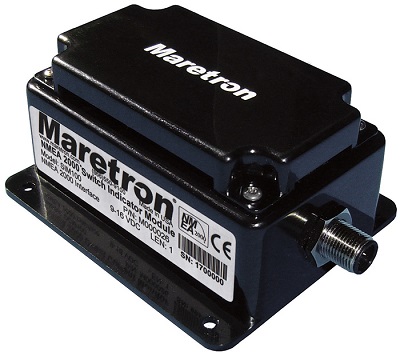
Maretron's Switch Indicator Module monitors switch closure devices including, but not limited to, safety equipment (e.g., heat, smoke, carbon monoxide, explosive vapor detectors), security systems (e.g., motion, vibration, glass break, door and port hole magnetic switches), and vessel monitoring equipment (e.g., valve closed/open, high water bilge). The SIM100 continually monitors these switch closure devices and broadcasts information over the NMEA 2000® network about the switch state so the crew can be alerted to potential conditions or problems that warrant further investigation.
Advanced features of the SIM100 include the ability to detect whether or not power has been disconnected from the monitored device or if the signal wires have been disconnected due to either corrosion, tampering, or for any other reason (if the monitored device is so equipped).
With the SIM100, you can rest assured that critical sensors are receiving power, signal wires are connected, and all the safety, security and vessel functions are under constant supervision. SIM100 output information is then displayed with networked NMEA 2000® equipment such as Maretron's DSM250 or DSM410 dedicated displays or with NMEA 2000® compatible software such as Maretron's N2KView®.
Best of all, the SIM100 is NMEA 2000® certified so you can view any and all switch indicator status anywhere on the vessel using a compatible NMEA 2000® display. The SIM100 is a key component of Maretron's N2KView® vessel monitoring and control system.
Applications:
- Heat detectors
- Smoke detectors
- Carbon monoxide detectors
- Gas detectors
- Bilge water detectors
- Magnetic switches
- Glass break detectors
- Clogged fuel filter detection (Excessive vacuum)
- Door, hatch, and porthole magnetic switches
Download documents: SIM100 Datasheet SIM100 User Manual
TMP100
Maretron's TMP100 measures the temperature for up to 6 temperature probes and reports the information over an NMEA 2000® network. The TMP100 supports up to 4 thermistor probes and 2 high temperature thermocouple probes. Optional thermistor probes (-20°C to 80°C or -4°F to 176°F) cover a wide range of applications including cabin air temperature, engine room air temperature, refrigerator/freezer temperature, under bolt temperature (inverters, charges, pumps, motors, etc.), tank temperatures (live well bait, hot water, etc.), and air duct temperatures. The optional thermocouple probes (0°C to 900°C or 32° to 1652°F) are used to measure Exhaust Gas Temperature (EGT) as part of a comprehensive fuel management system.
Best of all, the TMP100 is NMEA 2000® certified so you can view any and all temperature information anywhere on the vessel using a compatible NMEA 2000® display. The TMP100 is a key component of Maretron's N2KView® vessel monitoring and control system.
Features:
- Six external temperature probes are measured and broadcast Over NMEA 2000® network
- Four channels for thermistor probes and two channels for high temperature thermocouple probes
- Wide variety of applications supported with optional temperature probes
Applications:
- Cabin temperature
- Engine room temperature
- Under bolt temperature (Inverters, chargers, pumps, etc.)
- Refrigerator / freezer temperature
- Tank temperatures (Live well bait, hot water, etc.)
- Air duct temperature
- Exhaust gas temperature
Download documents: TMP100 Datasheet TMP100 User Manual
VDR100
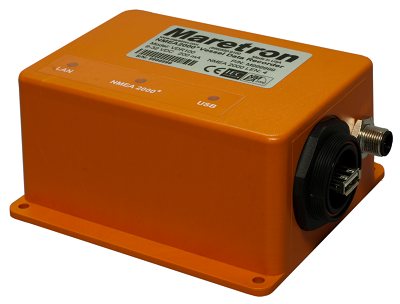
Maretron's Vessel Data Recorder (VDR100) is used to record messages transmitted from every product interconnected on the vessel's NMEA 2000® network. Each message is stored using solid-state memory technology with simple data retrieval via a removable USB flash drive. The supplied 16 Gbyte USB Flash Drive will hold weeks or more of data, and with the optional purchase of a larger USB Flash Drive, a year or more of data can be stored. And you never have to worry about losing the most recent data because the VDR100 uses a circular buffer where the oldest data is overwritten only after the entire memory is filled.
Recorded vessel data can be used in many ways including performance analysis, vessel tracking, preventative maintenance, network diagnostics, warranty incident, and accident investigation, all in an effort to reduce operating cost and improve safety. As an example of how the recorded data might be used, consider an NMEA 2000® fuel flow monitor plugged into the network, which will provide a complete record of how much fuel was used and how fast it was used. With a GPS antenna/receiver plugged into the NMEA 2000® network, you will have a complete record of where the vessel has been including its speed and course over ground.
Analyzing and graphing recorded data is done using a spreadsheet program like Microsoft® Excel®. Simply remove the USB Flash Drive and plug it into a PC or Mac and run Maretron's free extraction software (N2KExtractor®). Choose any or all of the recorded data including the associated dates and times and the program will create a comma delimited file (.csv) that can be read into a spreadsheet for graphing or any other type of data analysis.
With the VDR100, you have a complete record of all the information produced by NMEA 2000® products connected to the vessel's network. And because the VDR100 is engineered and manufactured to the highest standards (IEC 60945 Maritime Navigation and Radio Communication Equipment), your data is safely protected in a compact waterproof housing.
USB flash drives
Depending on how much data you wish to record without overwriting older data, the following table can be used to determine the capacity of the USB Flash Drive you need. These figures are estimated assuming a 25% loaded system (approx 463 frames/second).
| Recording Period | Media Storage Capacity |
|---|---|
| 1 second | 7862 bytes |
| 1 minute | 471,750 bytes |
| 1 hour | 29 MBytes |
| 1 day | 680 MBytes |
| 1 week | 5 GBytes |
| 1 month (30 days) | 21 GBytes |
| 1 year (365.25 days) | 248 GBytes |
Applications:
- Performance analysis
- Vessel tracking
- Preventative maintenance
- Warranty incident
- Accident investigation
Download documents: VDR100 Datasheet VDR100 User Manual

